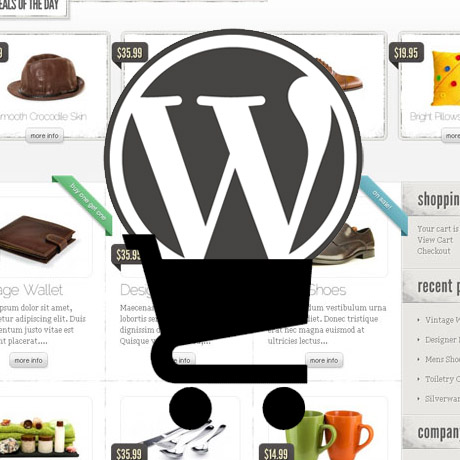
Product Pricing
Product pricing is one of the trickiest things to determine as far as market positioning goes. Why? There are several market forces that need to be carefully considered, on top of the actual cost of producing or creating the product to be sold, before you can actually arrive at a Selling Price that is equitable to both buyer and seller. Intellectual/intangible/Service products or Works of Art are even harder to price because their value is greatly hinged not only on the actual skills and experience of the creator but on his perceived market persona as well. Premium or Custom WordPress themes are intangible products whose pricing has often been debated and discussed. One recent hot topic on this was ThemeForest’s price increase on WordPress themes sold in their marketplace.
WordPress Themes – Commodity or Work of Art?
There has been a long-standing debate on how much a WordPress Theme should actually sell for. The WordPress Themes market has evolved greatly in a span of two to three years and a lot of discussions about fair pricing, competitiveness, costs, man hours, economies of scale, quality, fair market value, after-sales support etc. have gone on and on because this market has yet to reach its full maturity. The deluge of new premium themes flooding the market regularly from new but not necessarily seasoned web authors taking their designs to the marketplace has its pros and cons. D more themes equal more choices for buyers, which makes more income for authors? Maybe or maybe not.
The influx of these new premium WordPress themes in the market place definitely has a major impact on every theme’s individual pricing. Premium themes are slowly becoming “commoditized,” with very little differentiation from one theme to the next, turning into “common” products with common features and common functionalities. The market recognizes this “common-ness” and, without getting into too much detail about the law of supply and demand, this characteristic influences and eventually dictates their fair market value and eventually, the success of these themes. Often, the not-so “common” ones stand out and do better sales-wise.
It boils down to how much a buyer is willing to pay and how much the seller is willing to sell. This is not to devalue or diminish the efforts and man hours invested to create such themes but if the author decides to place his product in a marketplace where there are other similar products offering the same features and benefits then he is virtually agreeing to subject his product to the conditions (price control included) existing in that marketplace. It makes no difference how much time and effort he’s invested in creating the theme. It’s like a choice between selling in your own stand-alone boutique or selling in the mall. Different market forces. Different pricing strategies.
As a seller, you have to decide not only which distribution channel works best for your products, your business and your brand. You also need to come up with a marketing strategy that will help you achieve your business goals. Taking your products to a marketplace has its pros and cons and opening up your own store has its own benefits too. Some authors do both to ensure that their products get maximum exposure in the marketplace and in their own storefront.
How Much is Your Time Worth?
Cheap is relative. The Internet has made the global economy a tangible reality and prices do matter depending which side of the globe you are. Placing a dollar sign, a euro symbol, a peso sign, or whatever currency symbol in front of a number will have different values depending on where you are in the world. A cup of coffee in the USA is probably worth a week’s wages in Bangladesh. Because the currency scales are not equal what is cheap in one country may be exorbitant in another.
That’s why pricing is really tricky. It creates the market you want or eliminates the market you don’t want. But regardless whether your target market can afford you or not, your pricing strategy will attract the market you want to service. Those who can afford to buy will simply buy regardless of the price while those who can’t will scrimp and save just to afford what you have to offer especially if you are selling what they are looking for. These customers might not necessarily buy in bulk but definitely they will turn into loyal customers as long as they keep getting the kind of quality product they need. The question now is how much is your time worth and at what price are you willing to sell your product.
From the WordPress author’s perspective, there are many elements involved in computing how much a WordPress theme is worth. No it’s not about the selling price but the worth of each theme according to what was invested in it. Every author’s investment in each theme he creates includes actual man-hours worked on the theme, software bought and used, training, demo files, documentation files, psd files, support system setup, and so much more. Quite a lot actually.
How the author intends to get back a return on his investment (ROI) depends now on his pricing strategy, how much he is willing to sell his theme for (the actual selling price) to get an ROI and earn a decent profit as well. Low Price + High Volume? or High Price + Low Volume? Whatever he/she decides on will determine the distribution channels he chooses.
To Support or Not to Support?
People buy stuff expecting things to work. Whether they follow the instruction manual or not, they expect the product to function the way it was advertised. And if it doesn’t, they expect and demand some sort of support to help fix it or else they simply return the product, if they can. Major businesses and companies always include some type of support or warranty on items sold. They recognize that this is still part of the company’s marketing efforts for these specific products. WordPress authors need to think the same. Support is part of the marketing strategy of any successful business. Even if the customer is wrong. Of course, that doesn’t mean that abusive customers can just have their way. One sure fire way of decreasing the probability of customer complaints and the need for extensive support is to make sure that every theme released is as much as possible thoroughly tested and meets standard WordPress requirements.
In the end, the power of choice belongs to the consumer and it is he who determines whether a product is worth buying or not, affordable or not. No matter what the cost – if they need it, they will buy it. And they will keep on buying if they feel that they get the support from these WordPress authors about the product issues and questions no matter how trivial they are.






